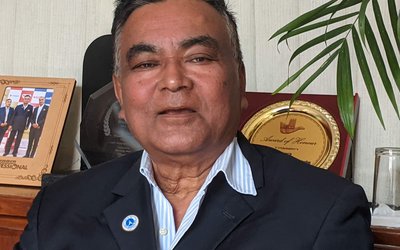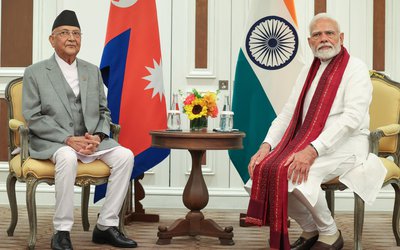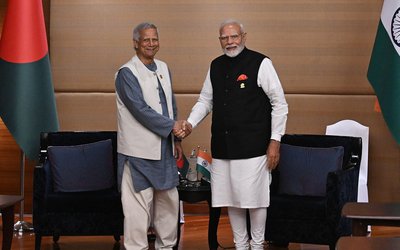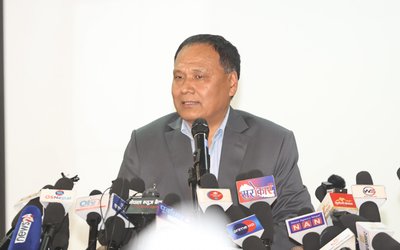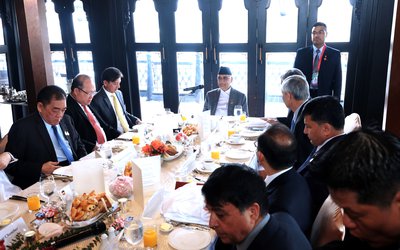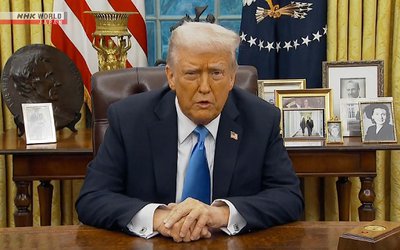
How LGCDP can distinguish itself from others?
This program is related to local governance and community development. This program is based on the sector-wise approach. This is not a project like others but a program. As this is a program-based approach with nine output areas, 4 outcomes, we mobilize all different government institutions under the program.
What components are there in the program?
The program components include policy, supply, demand and local development. Under the policy, there is Governance Reform included. Under the supply, there is service delivery and capacity development. Similarly, demands component addresses citizens empowerment and local development deals with socio-economic and infrastructure development. There are four program outcomes. After the completion of the program, citizens and communities hold their local governance actors accountable. Similarly, the local bodies are more responsive to citizen's demands and all citizens are provided with efficient and effective local services. The program will also help strengthen the policy and institutional framework for devolution, sub-national governance and local service delivery.
What is the aim of the program?
The program aims to strengthen the demand side and empower people by enabling them to raise their own concerns. For this, there are Ward Citizen Forums and Citizen Awareness Centers. Through social mobilization, we are empowering people. This program also promotes downward accountability. There is a local governance accountability facility.
How do you see the participatory planning?
Through participatory planning, we are incorporating the voices of the people and making the local representatives accountable to the people. We are also mobilizing the civil society organizations to achieve the goal. Similarly, the aim is also to increase the revenue of local bodies, systematize local accounting system and transparency as well as to reduce the fiscal risk. The project is also related to the capacity building of local bodies. We also work to strengthen the local delivery mechanism, promoting periodical planning and annual planning as well as strengthening the monitoring and evaluation.
In the absence of the elected local bodies, where do you fit LGCDP?
Over the last fourteen years, there is an absence of the elected local bodies. In most of the centralized countries in the world, police is given responsibility to collect the information of individuals at the village level. People have a long practice to follow VDCs to perform day to day works. Nepalese grew up in such a system. For the last 14 years, however, there has been no elected representative -- all the administrative and political role is not given to VDC secretary.
How do you see the Ward Citizen Forum then?
We have introduced the Ward Citizen Forum to make local bodies more effective. It is represented by all different stakeholders living within the ward. The Forum consists of 25 members from different sectors. There is a representation all ethnic groups, castes and women. The members also include all community groups, including mother group and forest group. Children and school management committee, health manager committee and senior citizens committee are other groups. It also includes women volunteer health workers. This group chooses the chairman among the members.
What is the structure of Ward Citizen Forum?
Each VDC has nine ward citizenship forums with 25 members. There are 225 members in each village who hold annual meetings to decide the budget and development programs. The forum is now working as a change agent of community. Since our social indicator is very low, there is the need to transform the community. This is just a temporary arrangement and we cannot claim this as an alternative to the elected system.
How do you see the role of grass root organizations to transform the society?
Building physical infrastructures alone cannot bring transformation in the community. The good example is Birgunj to show how it fares with a poor human development record despite having all the physical infrastructure -- education facilities, airport, irrigation with Gandak Nahar, Telecommunication, railway, roads, hospitals and health facilities. Birgunj, however, is a municipality with the lowest human development index. In terms of infrastructural development, Birgunj is second to Kathmandu. However, it has not brought any change in the life of the community. The municipality constructed a big complex with a swimming pool, the watch tower and modern town hall. There is the largest stadium in Birjung after Kathmandu. It is also Nepal’s commercial and industrial capital.
What is the state of Parsa?
Despite all these facilities, there was just 47 percent literacy when I was executive officer of Birgunj Municipality in 2005. It was shocking for me to know this. When my own home district Syangja had just 2 or 3 percent literacy rate, Birgunj had high schools and colleges. This happened because we were unable to put development agenda in Birjung. We were unable to change people’s mindset and failed to generate social capital. Although many people of upper class, mostly the rich people, are studying in high class universities in India, USA and other parts of the world, the poor have remained in the villages. We also failed to empower women. It has been difficult to contain child marriage. Dowry continues to be a social evil. There is a cycle of poverty due to early marriage and low literacy.
Why is women's development important?
We need to empower women and protect the children to transform the community. Our efforts will be to make the citizens forums as change agent. The citizen forum has been making efforts to reduce social anomalies in the villages. It also tries to reduce the discrimination against dalits and discriminatory behavior. This forum is launching social reform programs. It also works to end the discrimination among all citizens.
What role did Ward Citizen Forum play during the earthquake?
The role of ward citizen forum was very important. The support carried out by the forum in relief and rehabilitation was extraordinary. After working with ward citizen forum, local administrators are praising the role of forum in rescue and relief operations. District Disaster Relief Committee of Lampung even sent a note of admiration for the committee. Had not the ward citizen forum been there, the situation would have been more difficult in rescue and rehabilitation. As Forum is an institution represented by different stakeholders of the areas, they are the legitimate entity at the grass root level. All the district administration officials know and understand the importance of Ward citizen Forum.
How did LGCDP get involved in the rescue mission?
After April 25 earthquake, the high level meeting consisting of deputy prime minister Prakash Man Singh and Secretary Dr. Somlal Subedi and development partners discussed how to get involved in relief operations, reaching directly to earthquake victims. On April 29, we developed the emergency relief and response guidelines. Our guidelines directed to constitute an emergency relief committee under the chairmanship of secretary of VDC, consisting of all the chairs of Ward Citizen Forums of villages and woman members. The Ministry released 140 million rupees for 14 districts.
Where was the money spent?
Out of 14, five most affected districts, Gorkha, Sindhupalchowk, Nuwakot, Dhading and Rauwa got an additional 900,000.00 rupees for each VDC. Each ward of 43 municipalities of most affected districts was given Rs.200,000.00. Other VDCs got 450,000.00. The money was used to purchase food for seven days, construction of temporary shelters, and providing access to drinking water and sanitation. Similar was medical treatment. We sent money asking the committees to spend it within a month.
How did you manage the money?
As there were several complex procedural processes involved in the release of the budget, the Ministry issued directives to all DDCs to use the available money for relief to be replenished later by way of additional allocations. We were able to spend 96 percent of our budget in 25 days. The money provided through our committee was the first money to reach rural Nepal as the government’s fund.
Why is the concept of the forum important?
At a time when there is a division in the district on the basis of political parties, the forum is the only organization which can play a neutral role. VDC secretary of Ghushel village of Lalitpur district told me that they have to leave the village in absence of Ward Citizen Forum. The recently concluded National Advisory Committee meeting of LGCDP II, consisting of representatives of 14 development partners and various government offices, highly praised their role.
How will LGCDP work in future?
A recently concluded National Advisory Committee meeting of LGCDP II adopted guiding principles in formulating Annual Strategic Implementation Plan for 2015/16. The meeting also reviewed the progress in the execution of current year’s Annual Plan and interacted with different stakeholders. The meeting also took the decision specifically focusing in earthquake affected districts. With its successful role in rescue and relief mission, the meeting decided to expand Community Awareness Centers in all the Wards of VDCs of highly affected districts at the rate of one CAC per ward. Similarly, the meeting also decided to implement livelihood improvement plan, enhance the capacity of Ward Citizen Forum and psycho-social counseling for earthquake victims.
What would you do for the earthquake-hit areas?
Taking into account the massive damage in 14 districts by the 25 April earthquake and its aftershocks, we have adopted a two-pronged approaches in formulating the Annual Strategic Plan for 2015/16. We have decided to expand Citizen Awareness Centers in all the wards of VDCs in the highly affected districts, enhance the capacity if its members to implement livelihood improvement plan and restore the service delivery of local bodies. Our second approach is to carry out governance reform activities in all the districts in line with the Strategic Implementation Plan and LGCDP II program document.
How do you view the program’s progress?
LGCDP II is one of the highly successful programs. For instance, 90 percent of VDCs and Municipalities conducted ward level planning workshop in 2015/16 and 85 percent ward level planning workshops documented participation of women, children and DAG, 5000 new Community Awareness Centers established and 4300 CACs graduated. Similarly, 600 CACs were revised.
- IME GROUP: Expands Into Paper Industry
- Mar 24, 2025
- CPN UML: Instigated By India
- Mar 23, 2025
- ADB’S CHIEF ECONOMIST: Nepal Reduces Poverty
- Mar 11, 2025
- FM DR. DEUBA: A Successful Visit
- Mar 11, 2025
- MD GHISING: Target Of Personal Grudge
- Mar 09, 2025





